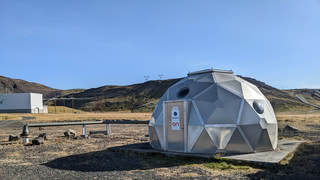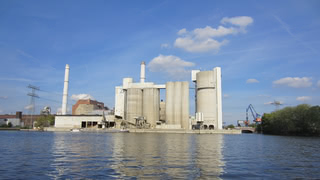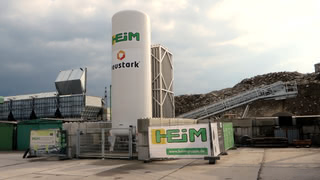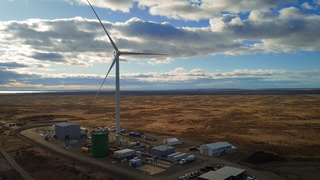Is Carbon Capture and Storage more expensive than we thought?
A controversy about the Hammerfest LNG plant on the Norwegian island Melkøya raises questions about the affordability of post-combustion carbon capture and storage. Equinor wants to electrify its operations - and said CCS would be too expensive.
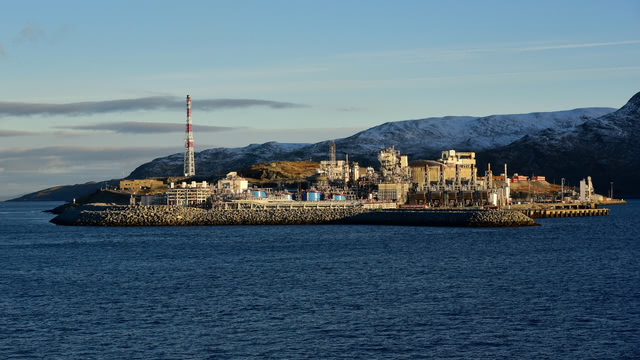
In northern Norway, on the island of Melkøya near Hammerfest, Equinor operates one of Europe's largest fossil gas processing facilities. Operational since 2007, the Hammerfest LNG plant prepares and liquefies gas from the nearby Snøhvit field for ship transport.
The Snøhvit gas field is also the location of one of Norway's carbon capture and storage (CCS) projects. Fossil gas from the Snøhvit field contains between 5 and 8 percent carbon dioxide. Before liquefaction, that carbon dioxide has to be separated from the fossil gas, which also happens on Melkøya. Carbon dioxide is then transported back via pipeline and injected into geological formations under the Barents sea.
As far as one can say this about any CCS project, the Snøhvit carbon capture project is relatively successful. Despite some early hiccups, it has been storing around 700 thousand tons of carbon dioxide per year since 2008. It is one of the longest-running dedicated CCS projects worldwide (not counting Enhanced Oil Recovery).
Equinor wants to electrify the Hammerfest LNG plant
In 2022, Equinor announced the Snøhvit Future project, a plan for substantial reinvestments at the Hammerfest LNG plant. Part of that plan is to electrify operations. Currently, Equinor runs gas-fired power plants on Melkøya to run gas compressors and other equipment.
With Norway's power grid already having a very low carbon footprint — and ignoring the fact that Norway's green electricity is regularly double-counted by selling green electricity certificates — Equinor said that this plan would reduce emissions by around 850 thousand tons per year. That corresponds to around two percent of Norway's emissions.
But not everyone welcomed this plan. Equinor's operations would consume an additional 3.6 Terawatt hours per year from the local electricity grid. It relies on plans for a controversial electric transmission line that crosses Sámi reindeer herding areas.
The environmental organization Bellona and politicians from several parties proposed to investigate an alternative: could Equinor achieve the same emission reductions with carbon capture and storage?
It is certainly an interesting example of Norway's conflicting relationship with climate change. A debate about how to reduce emissions from gas processing while ignoring the elephant in the room: the emissions from the gas itself once it is burned. The environmental youth organization Natur og Ungdom was a lone voice demanding closure of the plant instead of electrifying it.
The emissions caused by exported LNG from Melkøya are almost ten times as much as the combined emission reductions from the existing Snøhvit CCS project and a potential emission reduction by either electrification or CCS for the plant's energy emissions.
Norways double role, wanting to be a climate champion developing the technologies needed to tackle climate change, and at the same time wanting to stay an oil and gas superpower, is an interesting topic on its own, but that shall not be the main purpose of this text. The discussion about CCS at the Hammerfest LNG plant has implications beyond Norway.
With two proposals on the table — electrifying operations or implementing carbon capture and storage — Equinor was pretty unequivocal about which it prefers: the electrification path.
More than 500 Euro per ton of CO₂
Equinor expected that the costs of avoiding one ton of carbon dioxide on Melkøya via CCS would be around 6,500 Norwegian kroner — around 570 Euro or 620 US Dollars. An extremely high price, and one that eventually settled the debate. In August 2023, the Norwegian government approved Equinor's electrification plans.
But why did Equinor estimate such high prices for CCS? And what does that mean for other industries hoping that CCS provides a relatively affordable path to decarbonize their operations?
It appears conditions for CCS on Melkøya could not be better. Regarding CCS, Equinor is one of the most experienced companies worldwide. The company already operates a carbon capture facility on Melkøya and a CO₂ injection well in the nearby Snøhvit gas field. For electrification, Equinor will have to buy electricity from external sources to replace energy from its own gas. With CCS, it could continue using its own gas.
Given these favorable circumstances, one may ask: If Equinor cannot do CCS for an affordable price on Melkøya, why would anyone else think they can do it?
Equinor expected high costs due to some unique conditions on Melkøya. Being an island, there are space constraints, and Equinor expected that the LNG plant would have to shut down for 170 days to implement carbon capture.
The company had already investigated the possibility of full-scale CCS on Melkøya from 2009 to 2010. Equinor estimated costs of 4,500 to 6,000 Norwegian kroner per ton of carbon dioxide. Inflation corrected, that is a similar number to the more recent estimates from Equinor.
Those numbers were based on previous studies for a project called Mongstad — which brings us to one of the less successful chapters of the history of CCS in Norway.
Norway's Moon Landing was too expensive
CCS in Norway started in the 1990s after the country introduced a carbon tax. That made it attractive for Statoil, back then the name of the company today known as Equinor, to implement underground storage of carbon dioxide from a gas processing facility in the Sleipner gas field. The Sleipner CCS project has been running since 1996. The similar Snøhvit CCS project followed in 2008.
However, Norway had plans to use CCS much more extensively. A gas-fired power plant at the industrial site and oil refinery Mongstad should have been the first large-scale fossil-fuel power plant with CCS. In 2007, Norway's back-then prime minister Jens Stoltenberg said about Mongstad: "This is the big project for our country. It is our moon landing."
Yet, Norway didn't land on the moon. The Mongstad CCS facility would have been too expensive. "Moon landing crashes for Jens" was one of the headlines when it became clear in 2013 that the Mongstad CCS facility would never be built.
The same is not true for the Mongstad power plant. It was one of the larger emission sources in Norway until it was eventually shut down a few years ago. The Mongstad gas plant is thus an example of how the mere promise of carbon capture can be enough to justify fossil fuel projects.
But why did Mongstad crash-land, while Equinor appears to run reasonably successful CCS projects at Sleipner and Snøhvit? Why is it that Equinor says it cannot possibly be asked to use CCS for gas compressors and other energy needs, while it does use CCS for CO₂ separated from fossil gas at the same location?
The two are not the same, and while the conditions on Melkøya may add some additional challenges, there is something that Mongstad and Melkøya have in common. It is a challenge for every CCS project seeking to decarbonize gas combustion processes: the low concentration of carbon dioxide in the flue gas.
The majority of operational CCS projects are connected to processes with highly concentrated carbon dioxide emissions. The existing CCS projects at Sleipner and Snøhvit operate on gas processing plants that separate methane from carbon dioxide, producing an almost pure stream of the latter.
Gas power plants or other facilities that burn fossil gas to generate energy are very different. The concentration of carbon dioxide in the flue gas can be as low as three percent.
Extracting carbon dioxide from such flue gas is usually done via a process called amine washing. Apart from high costs, there are also potential health concerns around amine washing. When Mongstad was canceled, these concerns were cited as one of the reasons. However, it was also suspected that those health concerns were overblown in order to have a justification to stop a project that was simply too expensive.
Equinor thinks CCS on Melkøya would cost four to five times as much
Despite the history of Mongstad and the fact that it was canceled due to high costs, the extreme cost estimates from Equinor for the Hammerfest LNG plant are still surprising. A master thesis about the Mongstad project from 2007 lists cost estimates between 29 and 85 Euro per ton of CO₂ avoided. Inflation corrected, that would be around 120 Euro at the upper end. A lot less than the 6,500 Norwegian kroner (570 Euro) Equinor cited for a potential CCS project on Melkøya.
In other words, Equinor thinks that CCS on Melkøya would be four to five times more expensive than what public sources cited as costs for Mongstad.
We can speculate how much the specific conditions on Melkøya contribute or whether Equinor was already set on the electrification project and therefore cited unrealistically high costs — or whether Equinor simply knew better that the real costs of such a project would be higher.
An article by Norwegian newspapers Aftenbladet and N24 cites Mona Mølnvik, a scientist from Norway's SINTEF institute and one of the leading CCS researchers. "If it is the case that a project to capture CO₂ in Norway becomes so expensive, actors in Norway and internationally, and we who are researching this, need to understand how this can happen," Mølnvik said, according to E24/Aftenbladet. "The alternative is to say that CO₂ capture at gas power plants is impossible to implement."
Climate scientist Glen Peters pointed out in a social media post that Equinor's statements are particularly noteworthy due to the company's involvement in another project called Northern Lights. The Norwegian oil giant wants to provide carbon dioxide storage options for industries all over Europe.
CCS is too expensive for Equinor, but it still wants to sell it
The Northern Lights project is a CO₂ terminal currently being built near Bergen, a collaboration between Equinor, Shell, and Total. Equinor and its partners want to establish an infrastructure that European companies can use to ship their emissions to Norway and store them below the North Sea.
One of the Northern Lights' partner projects also faced challenges due to high costs. Plans for carbon capture at the Klemetsrud waste incinerator in Oslo were put on hold. Its operator cited cost increases due to inflation when I asked them for a statement last year.
CCS is often named as a relatively affordable emission reduction option for industries. That may be true for processes that deliver highly concentrated CO₂ streams, but it is likely not true for gas combustion processes. Many industrial emissions are those gas combustion processes where CCS is particularly challenging.
Knowing these challenges, one may have doubts whether processes like steam cracking should be considered as particularly well suited targets for CCS. And by the way, one may also have doubts about how realistic some of the cost estimates for direct air capture are. Obviously, carbon dioxide in the atmosphere is even more diluted than in the flue gas of a gas-fired power plant. The atmosphere contains only around 0.04 percent carbon dioxide.
Alternatives to post-combustion CCS in the early stages
There are alternatives to post-combustion CCS. One such alternative is oxyfuel technology. By burning fuel in pure oxygen, the flue gas is composed mainly of water vapor and carbon dioxide and contains no nitrogen. Separating carbon dioxide from oxyfuel processes is much easier and requires no amine washing.
But oxyfuel CCS technology is in the early stages. Only a small pilot plant in Texas is operational. Amine washing is still considered the more mature carbon capture technology despite previous failures and high costs.
Another alternative is to reform methane gas into hydrogen and separate carbon dioxide in the reforming step, while operating combustion processes with pure hydrogen. However, that option, also called blue hydrogen, is even less tested than oxyfuel technology. And if blue hydrogen can be made with low emissions — some scientists doubt that — burning it to generate energy may not be the best use case for scarce clean hydrogen.
Furthermore, all processes with fossil gas still have upstream methane emissions. In recent years, it became increasingly clear that those emissions along the fossil gas production chain are higher than previously assumed. CCS does nothing to avoid methane emissions.
A lot is still undecided about the role of CCS in a decarbonized future. However, experiences from existing and past projects should certainly inform future decisions. While statements from an oil and gas company like Equinor should always be taken with a grain of salt, they are unlikely to be biased against CCS.
Is CCS too expensive to decarbonize industries? It probably depends. If operated on processes that generate highly concentrated carbon dioxide emissions, CCS can be relatively affordable. But post-combustion CCS on very diluted carbon dioxide like in gas-fired processes is probably very expensive. Whether alternatives like oxyfuel technology will yield better results remains to be seen.
Author: Hanno Böck
Brief
-
Regular readers of this newsletter know about the problems with green electricity certificates in Europe (guarantees of origin) and regular double counting / double claiming of green electricity in countries like Iceland and Norway. I made a video about it: How Iceland and Norway sell their Green Electricity twice.
-
The quicklime producer SMA and the e-fuels startup Infinium announced a collaboration. While both technologies are interesting, their marketing is problematic. SMA will deliver CO2 from its lime production to Infinium to produce e-fuels. It is a typical CCU chain where CO2 emissions are not avoided; they are simply delayed. Once you burn the e-fuels, CO2 is in the atmosphere. These projects have a tendency of misleading marketing, and this one is no different. There is a maximal emission-saving potential of 50 percent when looking at the overall chain of such projects. Neither is this Zero Emissions Quick Lime, nor can they claim to produce climate-neutral or "ultra-low carbon" fuels.
-
Carbon Recycling International has announced plans for a green methanol project in collaboration with Chinese companies Guangdong Hydro Power and Jinagsu Dafu. The Icelandic company has already built two CO2-to-methanol plants in China with a capacity of around 100.000 tonnes per year each.
-
A paper and a corresponding editorial in the scientific journal Nature discuss the technologies that could replace oil refineries in a net-zero future.
-
Microsoft often touts itself as a company committed to climate action and even has announced plans to be carbon negative in the future. An interesting article published by Gist paints a different picture, telling the stories of employees trying to push Microsoft away from providing services for oil and gas companies.
